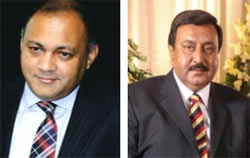This post is an excerpt from the forthcoming book, "150 Times Around the World," by Dr Jac Fitzenz. Its a culmination of his life's travels around the world and a compelling window into his vast journeys. Take a seat and come along for the experience of a lifetime as you join Dr Jac on his travels. Click here if you'd like to be notified when "150 Times Around the World" is available for purchase.
Pakistan
A Big Surprise
In 2007, I was contacted by Tahir Malik, Managing Director and Head of Human Resources at Descon, a large engineering and construction company headquartered in Lahore, Pakistan. Descon was operating across southern Asia from Dubai all the way to Hong Kong. The growing market potential was attracting competition from large multinational firms from America and Europe. The market was superheated. Shaikh Azhar Ali, the Chief Executive Officer, believed Descon needed to improve operations, protect its market share and open offices in the merging Southern Asia markets. To do that, he needed something innovative, leading edge and powerful—plus something already proven. This was not an easy requirement.
At that time Pakistan was in a state of political and military turmoil that was dealing with Saddam Hussein, Osama bin Laden and the UN forces attempting to control the region. Despite the political turbulence you could see and feel the economic growth. Still, when I was delivered to my hotel that first night, I was surprised to see the level of security. This was not a couple of fat retirees in ill-fitting uniforms. Fully armed troops patrolled the perimeter and the grounds. They swept our vehicle for hidden bombs including opening the hood and the trunk. Waved forward, we encountered a solid crossbar and tall iron gates. Checked again by these dour guards we were finally cleared and drove forward onto the hotel grounds—only to run a corridor of more armed men. I wondered if this was truly necessary.
Initially, the project had been planned for the end of 2007, but was postponed due to security problems in Lahore. Laura was very much opposed to me getting into such a situation. Yet, after many discussions she relented. It was to be a two-phase program starting with a survey research project. This was followed by initial work sessions with managers on March 11 and 12.
 The Team. Over the course of our time together, Shaikh Azhar and Tahir would prove to be first-rate executives. CEO Shaikh Azhar is a model leader—focused but pleasant, open to suggestion, eager to accelerate the growth of his company. The Shaikh is a trim, handsome six footer with a keen intellect. He’s a joy to work with. His right hand man Tahir is a bit shorter and stockier than his boss. He is a paradigm of a senior executive who is capable of counseling the CEO, while at the same time managing an efficient and effective, value adding, human resources function. I learned as much as I taught by working with these two fine gentlemen.
The Team. Over the course of our time together, Shaikh Azhar and Tahir would prove to be first-rate executives. CEO Shaikh Azhar is a model leader—focused but pleasant, open to suggestion, eager to accelerate the growth of his company. The Shaikh is a trim, handsome six footer with a keen intellect. He’s a joy to work with. His right hand man Tahir is a bit shorter and stockier than his boss. He is a paradigm of a senior executive who is capable of counseling the CEO, while at the same time managing an efficient and effective, value adding, human resources function. I learned as much as I taught by working with these two fine gentlemen.
Collectively, the three of us would work out an approach that enabled Azhar to strengthen the company to compete for the future.
Azhar and Tahir believed that while they had many competent managers and executives, the structure needed revamping to establish a shared vision and improve communication across the many projects operating around the region.
Descon had gone through centralization and decentralization programs in the past with little benefit. This was a 40,000-employee company with its very existence at stake. The Shaikh knew he needed a different approach. I was charged with developing a human capital management and measurement system that—and this was most important—would include predictability. With him and Tahir applying their local knowledge, I led the analysis of the entire working style of Descon management. We set it up to be highly interactive since this is the key to trust commitment and sustained effort.
We were basing our plan on the principles of my new HCM:21 system. This process takes management through a complete analysis of the elements that can affect an organization’s management of its human capital. It goes beyond the typical review of the labor market to include all forces that make human capital management a complex challenge. The result is a basic operating platform from which to make decisions regarding human capital and other investments. Over the next several months we would work together to achieve their objective. But we never anticipated what would happen first.


Recent Comments